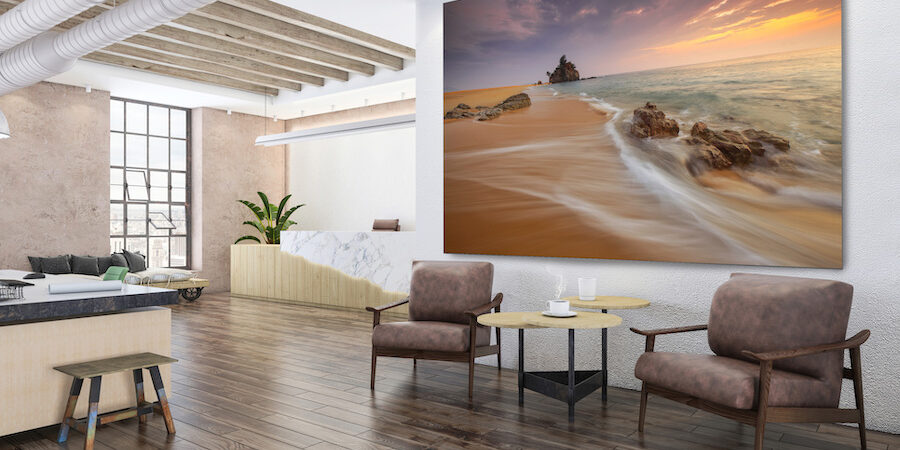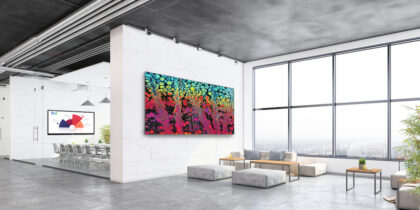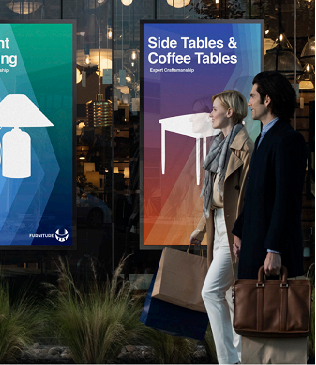No conversation about direct view LED display technology is complete without including pixel pitch — the relative proximity of the light pixels that make up the display. This is because pixel pitch will dictate the distance from which a screen looks its best.
Matching pixel pitch to viewing distance helps ensure an optimal experience and that end users and business partners are getting the most value from their fine pixel pitch LED display. Inappropriate pitch and distance result in a subpar viewing experience and a potential further outlay of cash to achieve the desired result.
Here’s what you need to know about pixel pitch and its relationship to the ideal viewing distances.
The basics
Put simply, pixel pitch is the distance (in millimeters) from the center of an LED cluster to the center of the next LED cluster alongside, above and below it. These LED clusters are mounted on circuit boards and backplates in an arrangement called “modules.” These modules are then placed together to create LED cabinets — consolidated electronics units seamlessly tiled and stacked to form video walls.
The cost of these video walls directly relates to the number of miniaturized electronics per square inch of the display, as well as the time it takes for the robotic manufacturing equipment on the assembly line to pick, place and wire literally millions of these lights. Pixel pitch definition is why two LED cabinets from the same brand, with the same dimensions and core attributes, can have very different prices.
Audience dynamics
The first LED displays to hit the market were for stadium replay boards and highway billboards. They were giant screens that could typically be seen from hundreds of feet away. They looked fantastic at a distance, but if you got close, they would look terrible because each LED light had a pitch of 16 millimeters, 20 millimeters or even higher, which made gaps between the LEDs evident and caused words and images to break up.
Advances in LED technology and manufacturing have made much tighter pitches possible. This has allowed fine pixel pitch LED displays to excel at close-range viewing in places such as airports and automotive design centers. Seamless video walls, such as the All-in-One LED IAC, in corporate offices and control rooms are now commonplace, too. Indeed, every facility can incorporate an effective fine pixel pitch LED display.
Of course, designers must think carefully about audience dynamics in general and the location of the viewer relative to the screen in particular.
A direct-view LED display with a very fine 1.5-millimeter pixel pitch will look fantastic when viewed from just a few feet away. However, if viewers are 30 feet away, their eyes wouldn’t pick up the visual difference between a 1.5-millimeter-pitch display and a 3-millimeter-pitch version. On the other hand, while that 3-millimeter display might look fantastic from 25-30 feet away, it wouldn’t look great if viewers were seeing it from much closer, as they would see each light pixel and the gaps between them. That makes determining the right pixel pitch vs. pixel size essential.
How to plan and deploy direct view LED signage
Everything you need to know about choosing your LED displays for optimal viewing indoors and out. Download Now
Finding the optimal pixel pitch
The easiest rule for determining the best pixel pitch is to equate 1 millimeter to 8 feet of viewing distance.
So, if a row of desks in a briefing center are 20 feet away from the display they’re facing, a pixel pitch of 2.5 millimeters is appropriate for delivering rich, crisp visuals. A finer-pitch LED display would produce similarly satisfying results but may cost more, while a higher pitch would save money but at the expense of image quality.
Pitch meets resolution
If the horizontal width of an LED cabinet is 384 pixels across, it would take 10 of those cabinets tiled side by side to realize 4K’s horizontal resolution of 3,840 pixels, so a 4K video wall might truly take up a full wall in a big room.
The finer the pixel pitch, the more light pixels are contained in each cabinet and the smaller the physical footprint of any given resolution. A fine pixel pitch LED display module with a 1.5-millimeter pixel pitch has many more pixels per module than, say, a 4-millimeter product, creating a higher resolution in a far smaller physical space — and with fewer materials.
Premium, attainable LED video walls
Smaller pixel pitches used to equal larger price tags, but Samsung recently announced its 1.5-millimeter pixel pitch LED video wall, the All-in-One LED IAC. With LED HDR and Samsung’s Dynamic Peaking technology, which analyzes content in real time and manages power consumption, the All-in-One LED IAC produces brilliant content that catches the eye against any background. With zero maintenance and only two hours to install, the video wall displays images with vivid color, reduced noise, and a full range of grays and blacks.
MicroLED changes the game
LED manufacturers have been gradually reducing pixel pitch for quite a while, even dipping below 1 millimeter for the finest-pitch LED displays. But the top-of-the-line displays use microLED technology, which makes the size of the lights themselves of paramount importance.
The Wall by Samsung features microLED displays in three pixel pitches — some of which are higher than conventional direct view LED alternatives. Furthermore, because the microscopic light pixels occupy so little space on the LED module, they can be surrounded by a pure-black background that facilitates spectacular contrast levels. The Wall All-in-One creates a seamless canvas for optimal message transfer.
Paired with HDR picture refinement technology, The Wall delivers visuals that rival what we are used to seeing on high-quality home televisions, making it ideal for auditoriums, boardrooms, command control rooms, home theaters, retailers, lobbies and more.
Smart selections
Pixel pitch is a critical factor in determining the best direct view LED display for any given situation. Finer pitch means better close-up viewing — but factors such as viewing distance and the specific technology the video wall utilizes also play a role in making the best decision about how to achieve the impact you seek.
Learn how you can enjoy brilliant LED performance with the new All-in-One LED IAC display. And find out how Samsung is helping streamline retail operations, drive customer engagement, improve workflows and boost ROI.








